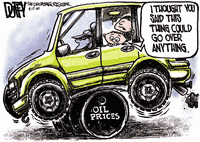The End of an Era? Traditional SUVs Losing Traction
WESTLAKE VILLAGE, Calif.: 31 May 2005 — Traditional truck-based SUVs captured just 12.1 percent of U.S. new-vehicle retail sales in April, their lowest market share since May 1996, according to Power Information Network, a division of J.D. Power and Associates. In contrast, more fuel-efficient car-based crossover SUVs continued to gain customer acceptance, as their share of the total SUV market reached a record 49 percent in April.
This movement away from traditional SUVs to crossover SUVs represents a continuation and expansion of the trend first identified by the Power Information Network (PIN) in August 2004.
“For many customers, the crossover SUV or sportwagon offers an appealing alternative to the traditional truck-based SUV,” said Tom Libby, senior director of industry analysis at the Power Information Network. “Most crossovers offer all-wheel drive, command-seating position, interior space and the seats of a traditional SUV along with car-like ride and handling. The crossovers generally weigh less and use a more compact package to provide better gas mileage as well.”
Current PIN transaction data regarding days to turn (the number of days a vehicle remains on a dealership’s lot before being sold), customer cash rebates and trading patterns collected from more than 6,000 new-vehicle franchises across the United States support these trends.
Days to turn
Traditional SUVs sat on dealer lots an average of 79 days before being sold in April 2005, the 11th consecutive month their days to turn has exceeded 75 days. In contrast, car-based crossovers sat on lots for just 48 days on average. Truck-based SUVs in every traditional SUV segment sat on dealer lots longer in April, on average, than the same-size crossover models. The days to turn for traditional SUVs have nearly doubled since late 2002 and early 2003, when they sat on dealership lots approximately 30 days.
Customer cash rebates
Customer cash rebate amounts declined for the auto industry overall and for SUVs in April 2005 compared to April 2004. However, two categories of traditional SUVs—fullsize and luxury—had 4 percent and 5 percent increases, respectively, in the amount of their cash rebates. The crossover luxury category, now with 10 models including the re-designed Mercedes-Benz M-Class, also had an increase in rebate amount (3 percent), reflecting the recent increased competition in this segment.
Trading patterns
Trading patterns clearly indicate customers are leaving their traditional SUVs in favor of car-based vehicles. The propensity of owners in each of the truck-based SUV categories to trade to a crossover has increased substantially in 2004 compared to 2005. This tendency among owners of fullsize SUVs has almost doubled. Almost 20 percent of traditional luxury SUV owners who purchased or leased a new vehicle in April switched to a crossover, and in the Northeast, surpassed 20 percent.
Transaction Prices
Despite softening consumer demand for traditional SUVs, vehicle prices continue to rise. Actual transaction prices and fewer rebates for truck-based SUVs increased one percent in April 2005 compared to April 2004, and the price of crossovers increased by a similar amount. Within the traditional SUV category, prices of entry models jumped 7 percent, fullsize vehicles 4 percent, and for both midsize and luxury models, 2 percent. However, these price increases for traditional SUVs have not been uniform across the United States, as prices of truck-based models in the Midwest and Northeast have actually declined.
About Power Information Network (PIN)
PIN’s automotive solutions are based on the collection and analysis of daily new- and used-vehicle retail transaction information from automotive franchises. PIN’s industry-leading automotive solutions incorporate consumer demand and sales information to improve results in product planning, marketing, sales, and vehicle production and distribution processes for its customers including pricing, revenue management, incentives optimization, and vehicle remarketing. Additional information is available at www.powerinfonet.com



